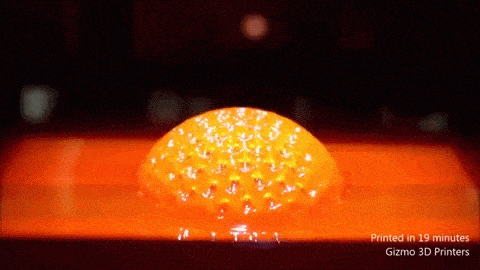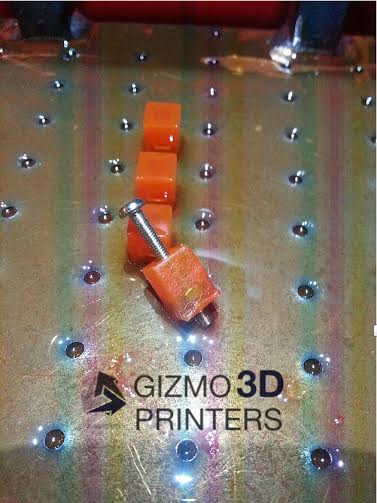 You may recall, back in March, we broke a story on a new DLP 3D printer manufacturer originating out of Australia, called Gizmo 3D. Their groundbreaking 3D printing method was unveiled, bringing with it blazing printing speeds, unlike anything we’ve seen within the DLP 3D printing space yet.
You may recall, back in March, we broke a story on a new DLP 3D printer manufacturer originating out of Australia, called Gizmo 3D. Their groundbreaking 3D printing method was unveiled, bringing with it blazing printing speeds, unlike anything we’ve seen within the DLP 3D printing space yet.
It’s been about 5 months now, and a lot has been going on for the company, run by founder Kobus du Toit. Since our story broke, and du Toit released his video of a Gizmo 3D printer printing an incredible 30mm in just 6 minutes flat, many people began taking interest in his technology.
“After our last video of skulls being printed went viral, some dentist companies contacted us asking if we could print teeth,” du Toit tells 3DPrint.com. “And I thought it should be really easy because I can already print the skulls. I noticed the current code wasn’t up to the task and I had to find solutions to the problems.”
Because the teeth that the dentists wanted printed were too complex of a design for Gizmo 3D’s technology at the time, du Toit needed to go back to the drawing board in order to make the code execute faster to accommodate for all the details required. After trying various ideas for pre-slicing into SVG files as well as pre-slicing into PNG files and even GIFs, he could not find a method which would work for displaying the continuous printing movie that his DLP 3D printers required, without overloading his computer. For those unaware, du Toit’s printers use the light projected from movies played on a DLP projector, in order to cure a liquid polymer resin, and build up solid objects.
Thankfully though, he then came across a piece of software called FFmpeg, which is used to generate movies from image files. He was able to change the code around in order to pre-slice into PNG files which would then be used to generate a movie for the continuous printing process. While this process worked quite well, he still noticed that the teeth were printing with very noticeable layers — layers not acceptable by dentists.
This is when du Toit came up with what he calls the “Super Smooth Package,” which allows the printer to move the Z-axis as slow as 3mm per minute with the potential to print as slow as 1mm per minute in the upcoming beta machines that will be released soon. This allows for 3D printing of layerless objects, although still not injection molded quality–du Toit says they are working to bring injection molded quality to their machines in the near future.
“The Super Smooth package still didn’t solve all of my problems,” du Toit tells us. “What I’m still seeing with continuous printing – the wall thickness needs to be really thin as I’ve stated previously. I had to upgrade the code to allow the user to hollow the object while slicing. I then noticed the hollow teeth that I was printing were really soft, so I created a honeycomb infill to strengthen the parts.”
He also realized that when slicing the objects he wanted to print, the process was just too slow, so he ended up creating a new slicing method that he calls “Distributed Slicing.” This method of slicing allows users to use cloud slicing, while keeping their objects securely on their local network/PC.
“This also means if you have power outages and your PCs are running on UPS (Uninterruptible Power Supply), you will be able to keep on slicing and printing,” du Toit tells us. “Whereas if you were slicing on the cloud, you will most likely lose your internet connection. I was living in South Africa where there are a lot of power cuts that are referred to there as load shedding. Another reason why you would want to keep the object on your local network – when you slice at 1 micron, the files get really huge. The resultant .gizmo file can be in the gigabyte range. This means you will have to wait for the file to download and use your bandwidth, which if you are limited can be a problem.”
This new “Distributed Slicing” will be incorporated into the Gizmetor software that will come with Gizmo 3D’s printers. Gizmetor will also be integrated with MeshMixer and MeshLab, allowing for comprehensive support generation and more.
Back in March, du Toit told us that he planned to launch a crowdfunding campaign for the Gizmo 3D line of printers on Kickstarter before the end of November. This time frame still holds up, but he has decided to use Indiegogo as the platform to launch the campaign, as it provides for more flexibility. Construction of the beta units of the Gizmo 3D printers is about to commence, with the crowdfunding campaign launching in time.
“We will assemble the beta machines and send them out to the 4 beta testers that we’ve assigned beta machines to,” du Toit tells us. “I believe we are on track to [launch our campaign] this November. It will give the beta testers at least two months for testing. Since we have been testing the alpha machine for more than a year, we believe the beta testers won’t find any hardware problems, there will only be software upgrades. After we launch, we will hire a full time developer to help us make the software even better. People can expect a lot of updates to the software really early on.”
Gizmo 3D certainly doesn’t seem like a fly-by-night company, and du Toit seems to be very enthusiastic about continuing to innovate upon his unique process of 3D printing. If all goes as planned, not only will Gizmo 3D provide for super fast printing options unlike anything we’ve seen yet (with the exception of perhaps Carbon3D’s machines), but also for extreme print resolution, reduction of noticeable layering, and the integration of other non-3D-printed parts.
What do you think about these latest advancements? Do you look forward to seeing the Indiegogo campaign go live in November? Discuss in the Gizmo 3D Printers forum thread on 3DPB.com.
Subscribe to Our Email Newsletter
Stay up-to-date on all the latest news from the 3D printing industry and receive information and offers from third party vendors.
You May Also Like
Precision at the Microscale: UK Researchers Advance Medical Devices with BMF’s 3D Printing Tech
University of Nottingham researchers are using Boston Micro Fabrication‘s (BMF) 3D printing technology to develop medical devices that improve compatibility with human tissue. Funded by a UK grant, this project...
3D Printing Webinar and Event Roundup: April 21, 2024
It’s another busy week of webinars and events, starting with Hannover Messe in Germany and continuing with Metalcasting Congress, Chinaplas, TechBlick’s Innovation Festival, and more. Stratasys continues its advanced training...
3D Printing Webinar and Event Roundup: March 17, 2024
It’s another busy week of webinars and events, including SALMED 2024 and AM Forum in Berlin. Stratasys continues its in-person training and is offering two webinars, ASTM is holding a...
3D Printed Micro Antenna is 15% Smaller and 6X Lighter
Horizon Microtechnologies has achieved success in creating a high-frequency D-Band horn antenna through micro 3D printing. However, this achievement did not rely solely on 3D printing; it involved a combination...
































